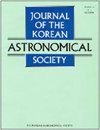在~ 1au的太阳风中观测到磁场的动力学性质下降
IF 0.8
4区 物理与天体物理
Q3 ASTRONOMY & ASTROPHYSICS
引用次数: 0
摘要
在这项研究中,我们利用星团观测,研究了在~1 AU的太阳风中观测到的磁衰减的动力学性质。我们研究了两种不同的磁降:一种是观测时间短的~2.5分钟,结构稳定;另一种是观测时间长一些的~40分钟,有一些波动和子结构。尽管在持续时间和磁结构上存在差异,但在这两个事件中离子的速度空间分布是相似的。速度空间分布在平行于磁场方向的各向异性更强,这与高纬度地区的观测结果不同。另一方面,电子表现出与离子不同的特征。电子的核心成分表现出与离子相似的各向异性,尽管各向异性要弱得多。然而,当离子在磁衰减中被加热时,核心电子被略微冷却,特别是在垂直方向上。日晕分量在周围太阳风的磁场减弱中变化不大。斯特劳分量只在其中一个磁衰减中被观察到。结果表明,离子和电子在磁减层中的行为不同,这是磁减层形成机制中需要考虑的问题。本文章由计算机程序翻译,如有差异,请以英文原文为准。
KINETIC PROPERTIES OF MAGNETIC DECREASES OBSERVED IN THE SOLAR WIND AT ~1 AU
In this study, we investigate the kinetic properties of magnetic decreases observed in the solar wind at~1 AU using the Cluster observations. We study two different magnetic decreases: one with a short observation duration of~2.5 minutes and stable structure and the other with a longer observation duration of~40 minutes and some fluctuations and substructures. Despite the contrast in durations and magnetic structures, the velocity space distributions of ions are similar in both events. The velocity space distribution becomes more anisotropic along the direction parallel to the magnetic field, which differs from observations obtained at high heliographic latitudes. On the other hand, electrons show different features from the ions. The core component of the electrons shows similar anisotropy to the ions, though the anisotropy is much weaker. However, while ions are heated in the magnetic decreases, the core electrons are slightly cooled, especially in the perpendicular direction. The halo component does not change much in the magnetic decreases from the ambient solar wind. The strahl component is observed only in one of the magnetic decreases. The results imply that the ions and electrons in the magnetic decreases can behave differently, which should be considered for the formation mechanism of the magnetic decreases.
求助全文
通过发布文献求助,成功后即可免费获取论文全文。
去求助
来源期刊

Journal of the Korean Astronomical Society
地学天文-天文与天体物理
CiteScore
1.30
自引率
10.00%
发文量
0
审稿时长
>12 weeks
期刊介绍:
JKAS is an international scientific journal publishing papers in all fields of astronomy and astrophysics. All manuscripts are subject to the scrutiny of referees. Manuscripts submitted to JKAS must comply with the ethics policy of JKAS. Six regular issues are published each year on February 28, April 30, June 30, August 31, October 31, and December 31. One year''s issues compose one volume.
 求助内容:
求助内容: 应助结果提醒方式:
应助结果提醒方式:


